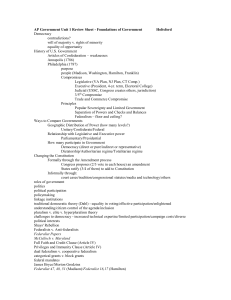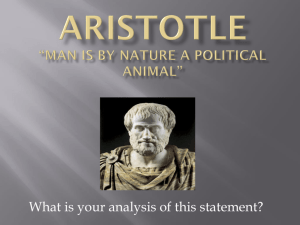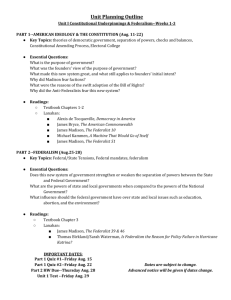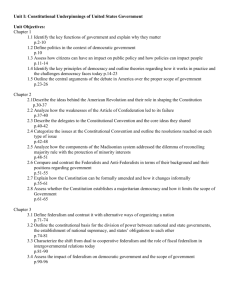AP - TWHSSturges
advertisement
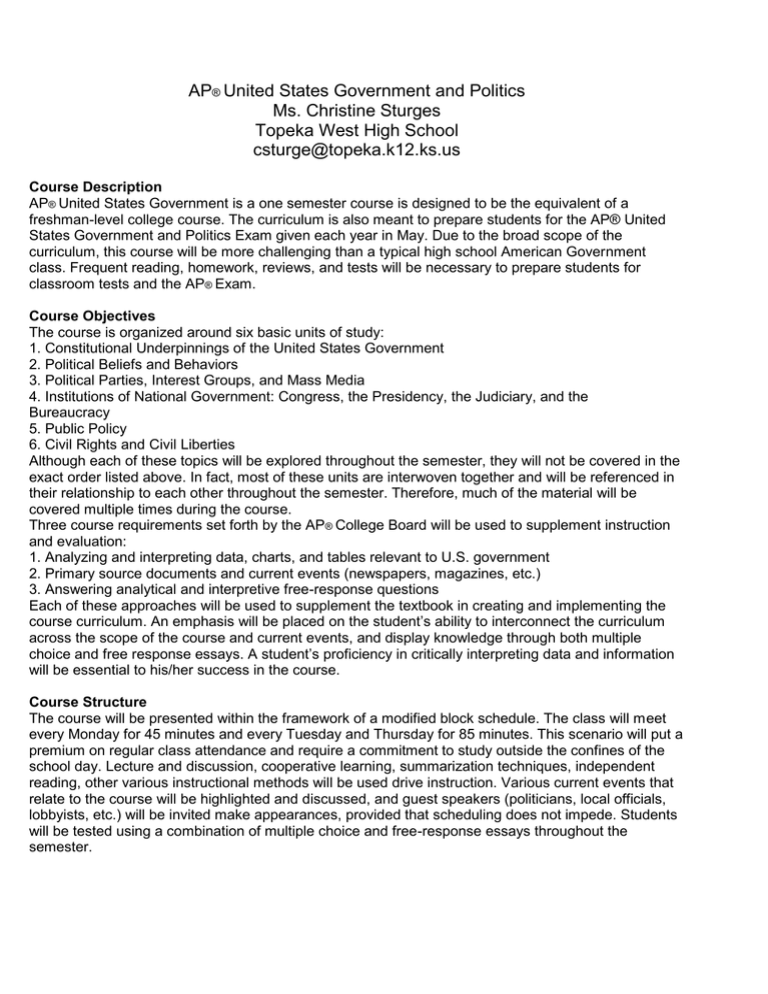
AP® United States Government and Politics Ms. Christine Sturges Topeka West High School csturge@topeka.k12.ks.us Course Description AP® United States Government is a one semester course is designed to be the equivalent of a freshman-level college course. The curriculum is also meant to prepare students for the AP® United States Government and Politics Exam given each year in May. Due to the broad scope of the curriculum, this course will be more challenging than a typical high school American Government class. Frequent reading, homework, reviews, and tests will be necessary to prepare students for classroom tests and the AP® Exam. Course Objectives The course is organized around six basic units of study: 1. Constitutional Underpinnings of the United States Government 2. Political Beliefs and Behaviors 3. Political Parties, Interest Groups, and Mass Media 4. Institutions of National Government: Congress, the Presidency, the Judiciary, and the Bureaucracy 5. Public Policy 6. Civil Rights and Civil Liberties Although each of these topics will be explored throughout the semester, they will not be covered in the exact order listed above. In fact, most of these units are interwoven together and will be referenced in their relationship to each other throughout the semester. Therefore, much of the material will be covered multiple times during the course. Three course requirements set forth by the AP® College Board will be used to supplement instruction and evaluation: 1. Analyzing and interpreting data, charts, and tables relevant to U.S. government 2. Primary source documents and current events (newspapers, magazines, etc.) 3. Answering analytical and interpretive free-response questions Each of these approaches will be used to supplement the textbook in creating and implementing the course curriculum. An emphasis will be placed on the student’s ability to interconnect the curriculum across the scope of the course and current events, and display knowledge through both multiple choice and free response essays. A student’s proficiency in critically interpreting data and information will be essential to his/her success in the course. Course Structure The course will be presented within the framework of a modified block schedule. The class will meet every Monday for 45 minutes and every Tuesday and Thursday for 85 minutes. This scenario will put a premium on regular class attendance and require a commitment to study outside the confines of the school day. Lecture and discussion, cooperative learning, summarization techniques, independent reading, other various instructional methods will be used drive instruction. Various current events that relate to the course will be highlighted and discussed, and guest speakers (politicians, local officials, lobbyists, etc.) will be invited make appearances, provided that scheduling does not impede. Students will be tested using a combination of multiple choice and free-response essays throughout the semester. Non-mandatory review sessions will be held throughout first and second semester in order to further students’ understanding of the curriculum and the AP® Exam itself. Student Evaluation and Assessment LATE WORK IS NOT ACCEPTED!!! Grades will be based on a combination of homework assignments and exams. Each test will be structured after the College Board’s AP® Exam, and will include both multiple choice and freeresponse questions. A student may complete one (1) extra credit project for the semester, which will only count for a maximum of twenty (20) points. This will involve a proposal of the student’s choosing, and must be related to the current topic of study. It must be completed before the 70 th day of the semester. It also must be academic in nature and be approved by the instructor. (Please understand that this is not a “grade-saving” option, only a method to “make-up” points for one typical homework assignment.) LATE WORK IS NOT ACCEPTED!!! Primary Text Welch, Susan, John Gruhl, John Comer, and Susan M. Ridgon. American Government. 10th ed. Belmont, CA: Thomson Wadsworth, 2006. Supplemental Resources About America: How the United States is Governed (www.america.gov) Balance of Power Between Congress and the President (AP® College Board Special Focus) The Federalist Papers (selected texts), The Anti-Federalist Papers (selected texts), The Constitution of the United States of America Print Media: The New York Times, The Wall Street Journal, Christian Science Monitor, Newsweek, etc. News Networks: CNN, NBC, CBS, Fox News, CNN, MSNBC (and accompanying websites) Websites: www.apcentral.collegeboard.com, http://people-press.org (Pew Research Center), www.pollingreport.com, www.regulations.gov, www.opensecrets.org (Center for Responsive Politics), www.electionstudies.org (American National Election Studies), www.fedstats.gov, www.census.gov, www.fec.gov, www.gpo.gov, www.whitehouse.gov, www.america.gov, and other appropriate websites Semester Outline/Pacing Guide Week Concepts 1 Topics Text Chapters Supplemental Materials Syllabus and Introduction Constitutional Underpinnings of the United States Government 1 American Revolution Enlightenment Ch. 2-3 ideologies (Locke, Montesquieu, Rousseau), reasons for separation from Britain Need for Government flaws and failures of the Ch. 2 Articles of Confederation, Shays's Rebellion Founding Principles/ purpose and scope, Ch. 2 Ideologies freedom, order, equality, fear of factions (political conflict) 2 Governmental unitary, Ch. 2-3 Theories confederacy, federalism, limited government, democratic system, republican system, pluralism, elitism, majority rule (excessive democracy and limitations) Constitutional Compromises Great Compromise, Three-Fifths Ch. 2 Compromise, Commerce and Slave Trade Compromise Separation of Powers Executive, Legislative, Ch. 2 and Judicial Branch functions, governmental powers (expressed, implied, inherent, reserved, concurrent, prohibited) Checks and Balances each branch's limitations on Ch. 2 powers in relation to other branches Party System Federalist and AntiCh. 2, 7 Federalist viewpoints Amendment Process Bill of Rights + 17, formal Ch. 2 and informal processes TEST #1: Constitutional Foundations and Underpinnings 3 Federalism definition and Ch. 3 overview of the system, governmental powers as they relate to federalism, successes and Second Treatise of Civil Government (Locke), Democracy in America (Tocqueville) The Federalist No. 16 (Hamilton) The Federalist No. 10 (Madison) About America (Similarities and differences between the United States and other forms of democratic government) The Federalist No. 47, 48, 51 (Madison), The Constitution of the United States of America, Marbury v. Madison The Anti-Federalist No. 17, 84 The Constitution of the United States of America The Federalist No. 17 (Hamilton), 44, 45 (Madison), About America (Overview of national, state, and local governments) challenges Types of Federalism dual, cooperative, fiscal (types of grants and mandates), devolution Ch. 3 Federalism in Action landmark Supreme Court decisions, federal/state relations, interstate relations Ch. 3 TEST #2: Federalism Chart: text. Pg. 80 (What Does the Federal Government Give the States Money to Do?) McCulloch v. Maryland, Gibbons v. Ogden
